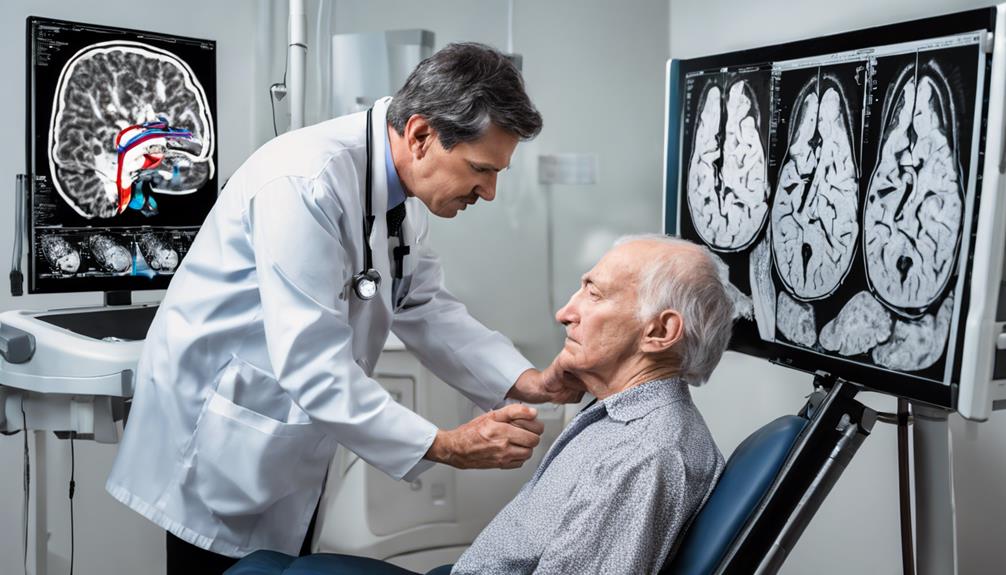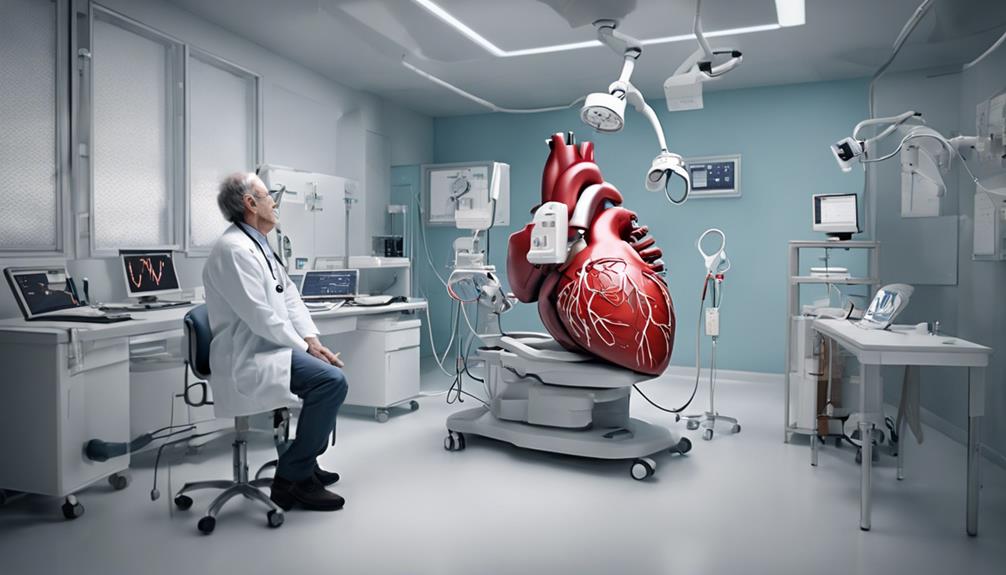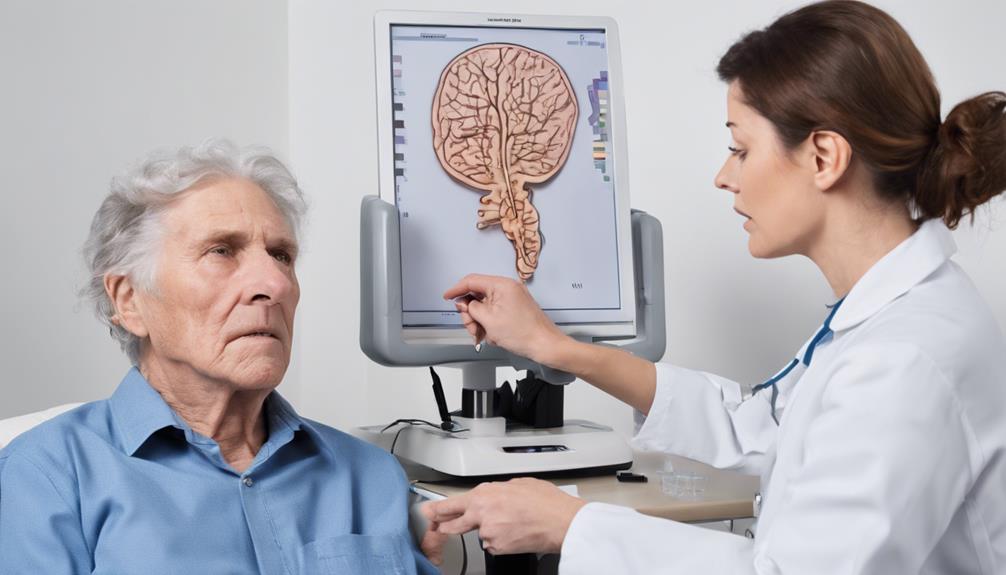When evaluating for Lewy Body Dementia, we begin by reviewing your medical history and symptoms. We assess factors such as memory, cognitive abilities, and any movement difficulties. A physical examination allows us to identify any muscle stiffness or balance issues. Blood tests and brain scans are used to confirm the diagnosis and rule out other conditions. Neurological assessments focus on cognitive functions and motor abilities. Sleep studies assist in early detection of REM sleep behavior disorder. Through a comprehensive evaluation and collaboration with specialists, a personalized treatment plan can be developed for you. Continue learning about the various tests by exploring different aspects of your health.
Key Takeaways
- Evaluate medical history, symptoms, and cognitive functions.
- Conduct physical and neurological examinations.
- Use blood tests and biomarkers for diagnosis.
- Employ brain imaging scans to detect brain abnormalities.
- Consider cardiac evaluation and sleep studies for comprehensive assessment.
Medical History and Assessment
In our evaluation process for Lewy Body Dementia, we start by carefully examining the individual's medical history and conducting an in-depth assessment. This includes reviewing symptoms such as cognitive fluctuations, visual hallucinations, and movement issues that are commonly associated with Lewy body dementia. By understanding the patient's medical history, we can gather vital information to aid in the diagnosis and treatment of this condition.
During the assessment, we evaluate various aspects such as mental abilities, sleep patterns, and autonomic nervous system functions. Cognitive tests help us assess the individual's thinking skills, memory, and problem-solving abilities. Sleep patterns are examined to identify any signs of REM sleep behavior disorder, which is often observed in individuals with Lewy body dementia. Additionally, we assess autonomic nervous system functions to understand how the body's involuntary processes are being affected.
Physical Examination

Upon completing the assessment of medical history and cognitive functions, the next step in our evaluation process for Lewy Body Dementia involves performing a comprehensive physical examination. This examination is vital in identifying various aspects related to the disease, such as movement issues, muscle stiffness, balance problems, and autonomic nervous system issues. Additionally, a neurological examination is conducted to evaluate cognitive abilities, alertness, and the presence of Parkinsonian symptoms. The physical exam for Lewy Body Dementia also includes an evaluation of mental abilities like memory, language, and problem-solving skills.
To help you understand better, let's take a look at the table below, which outlines the key components of the physical examination for Lewy Body Dementia:
| Physical Examination | Description |
|---|---|
| Movement Issues | Evaluating for any difficulties in movement |
| Muscle Stiffness | Checking for stiffness in muscles |
| Balance | Assessing balance control |
| Autonomic Nervous System | Examining autonomic functions |
Blood Tests for Biomarkers
Exploring the potential of blood tests to detect biomarkers associated with Lewy Body Dementia is an essential aspect of diagnostic evaluation. When contemplating blood tests for Lewy Body Dementia, it's vital to grasp how these tests can aid in diagnosis and provide valuable insights. Here are four key points to ponder:
- Identification of Specific Biomarkers: Blood tests can unveil specific proteins or markers that are associated with Lewy bodies in the brain, assisting in the diagnostic process.
- Confirmation of Diagnosis: These biomarkers can help affirm a diagnosis of Lewy Body Dementia, providing clarity for both patients and healthcare providers.
- Ruling Out Other Causes: Blood tests can also assist in excluding other potential causes of cognitive decline or movement issues, ensuring a more accurate diagnosis.
- Thorough Assessment: Blood tests for biomarkers play a vital role in the comprehensive evaluation for Lewy Body Dementia, contributing to a deeper understanding of the condition.
Neurological Evaluation

Moving from the discussion on blood tests for biomarkers, we now shift our focus to the neurological evaluation for Lewy Body Dementia. This evaluation involves evaluating cognitive functions, motor abilities, and behavioral changes. Neurologists conduct detailed examinations to detect symptoms like tremors, muscle stiffness, and balance issues. They assess reflexes, coordination, and eye movements to identify any neurological abnormalities that may point towards Lewy Body Dementia.
Cognitive tests play an important role in diagnosing this condition, focusing on memory, problem-solving skills, and language abilities. Through the neurological evaluation, healthcare professionals can effectively rule out other conditions by narrowing down the diagnosis based on specific symptoms and findings. This thorough evaluation helps in understanding the extent of cognitive impairment, motor deficits, and behavioral changes, providing valuable insights into the presence of Lewy Body Dementia and guiding appropriate treatment strategies.
Brain Imaging Scans
Brain imaging scans play an essential role in the diagnostic process for Lewy Body Dementia by allowing healthcare professionals to rule out other brain conditions and accurately detect specific abnormalities associated with this condition. Here are four key points about brain imaging scans in the diagnosis of Lewy body dementia:
- MRI and CT scans: These imaging techniques are used to rule out other brain conditions that may present symptoms similar to Lewy body dementia, helping to narrow down the diagnosis.
- Specialized scans like DaTscan and PET scans: These advanced scans can detect specific brain abnormalities linked to Lewy body dementia, aiding in confirming the diagnosis and differentiating it from other disorders.
- Nerve cell imaging: Scanning nerve cells in the heart through cardiac sympathetic imaging can provide valuable insights that support the diagnosis of Lewy body dementia, as nerve cell changes are characteristic of this condition.
- Role in identifying characteristic brain changes: Advanced imaging techniques play a critical role in identifying the specific brain changes associated with Lewy body dementia, assisting healthcare providers in the diagnostic process.
Cardiac Evaluation

In Lewy Body Dementia, cardiac evaluation plays a pivotal role in evaluating the heart's function and rhythm. Evaluating the heart through tests like an electrocardiogram (EKG) is essential in understanding and managing symptoms related to the autonomic nervous system in LBD.
Monitoring heart function is vital as it helps in addressing potential complications that may arise due to Lewy Body Dementia. These heart tests provide valuable information that aids in the overall care and treatment of individuals with LBD.
Sleep Studies

Our focus now shifts to the significance of sleep studies in the evaluation of Lewy Body Dementia, particularly in diagnosing REM sleep behavior disorder, a common symptom associated with this condition.
- Polysomnography: This type of sleep study can help in diagnosing REM sleep behavior disorder, which is often linked to Lewy Body Dementia.
- Monitoring Functions: Sleep studies track various aspects such as brain activity, eye movements, muscle activity, and breathing patterns during sleep to identify abnormalities.
- Early Indicator: REM sleep behavior disorder involves acting out dreams and can serve as an early sign of Lewy Body Dementia.
- Thorough Evaluation: By identifying REM sleep behavior disorder through sleep studies, healthcare providers can gain valuable insights into sleep-related symptoms, aiding in the diagnosis and management of Lewy Body Dementia.
Sleep studies, particularly polysomnography, play a significant role in understanding the relationship between sleep disturbances and Lewy Body Dementia. They provide healthcare professionals with essential data to detect abnormalities and offer a thorough evaluation of this neurodegenerative condition.
Neuropsychological Testing

When conducting evaluations for Lewy Body Dementia, one essential aspect to consider is neuropsychological testing, which assesses cognitive functions in individuals suspected of having the condition. These tests explore memory, attention, language, and executive function to unravel the intricate patterns of cognitive impairment that may be indicative of Lewy Body Dementia. By comparing these cognitive profiles with those seen in Alzheimer's disease, clinicians can better differentiate between various types of dementia.
To provide a clearer picture, let's look at a table illustrating the cognitive functions assessed through neuropsychological testing:
| Cognitive Function | Description |
|---|---|
| Memory | Evaluates the ability to recall and retain information |
| Attention | Assesses the capacity to focus and sustain attention |
| Language | Measures language skills including comprehension |
| Executive Function | Examines problem-solving and decision-making abilities |
Through these assessments, clinicians gain valuable insights into cognitive deficits, aiding in the diagnosis of Lewy Body Dementia. These evaluations help differentiate Lewy Body Dementia from other neurodegenerative conditions, ensuring more targeted treatment plans. Additionally, therapeutic interventions such as personalized reminiscence activities, including ‘memory lane DVD creation,’ can provide emotional comfort by reconnecting patients with meaningful past experiences. This approach not only stimulates cognitive function but also fosters a sense of identity and continuity for those affected by the disease.
Differential Diagnosis Process

When differentiating Lewy Body Dementia from other conditions, we look at specific symptoms that set it apart, such as visual hallucinations and fluctuations in cognition and alertness.
Various diagnostic tests, including brain imaging scans and cognitive assessments, are used to help pinpoint the underlying cause of the symptoms.
Consulting with specialists, like neurologists or geriatric psychiatrists, who are familiar with Lewy Body Dementia can enhance the accuracy of the diagnosis and guarantee appropriate management strategies are implemented.
Symptoms for Differentiation
In the differential diagnosis process for Lewy Body Dementia, core symptoms such as cognitive fluctuations, visual hallucinations, REM sleep behavior disorder, and Parkinsonism features are vital for differentiation.
- Cognitive Fluctuations: These include variations in attention, alertness, and thinking abilities throughout the day.
- Visual Hallucinations: Seeing things that aren't present is a common symptom in Lewy Body Dementia.
- REM Sleep Behavior Disorder: Individuals may physically act out their dreams, potentially causing injury during sleep.
- Parkinsonism Features: These can include tremors, stiffness, and slow movement, similar to Parkinson's disease symptoms.
Understanding and recognizing these key symptoms play an important role in distinguishing Lewy Body Dementia from other conditions, aiding in proper diagnosis and treatment.
Diagnostic Tests Utilized
Diagnostic tests play an essential role in the differential diagnosis process for Lewy Body Dementia, aiding in the accurate identification of this condition. Neurological exams and physical assessments help evaluate symptoms, while blood tests are conducted to rule out other causes of cognitive decline.
Brain imaging scans, such as MRI or CT scans, assist in identifying brain abnormalities linked to Lewy Body Dementia. Sleep evaluations are vital for detecting REM sleep behavior disorder, a common symptom of this condition.
Additionally, heart tests may be performed to assess autonomic nervous system dysfunction, which can be present in individuals with Lewy Body Dementia. These diagnostic tests provide valuable insights to healthcare providers in diagnosing and managing Lewy Body Dementia effectively.
Consulting With Specialists
Engaging specialists such as neurologists or geriatric psychiatrists plays a crucial role in the accurate diagnosis of Lewy Body Dementia. When consulting with these experts, they'll follow a specific process to guarantee a thorough evaluation. Here are four key steps they may take:
- Ruling Out Other Conditions: Specialists will work to differentiate Lewy Body Dementia from similar disorders by carefully considering various symptoms and medical history.
- Comprehensive Evaluations: Through medical history reviews, physical exams, cognitive tests, and imaging studies, specialists can gather essential information for an accurate diagnosis.
- Collaboration Between Healthcare Professionals: Teamwork among specialists in different fields helps in pinpointing specific features of Lewy Body Dementia and distinguishing it from other diseases.
- Expertise in Dementia and Movement Disorders: The specialized knowledge of these professionals is critical for a precise assessment and diagnosis of Lewy Body Dementia.
Referral to Specialists

Referring patients suspected of having Lewy Body Dementia to specialists such as neurologists or geriatric psychiatrists is vital for accurate diagnosis and thorough evaluation. These specialists possess the expertise required to conduct detailed evaluations and assessments specific to dementia and movement disorders.
When primary care providers suspect Lewy Body Dementia, they may refer patients to these specialists for further evaluation. Specialists are equipped to perform thorough cognitive tests, physical exams, and review medical history to confirm the diagnosis accurately. By collaborating with specialists, individuals with suspected Lewy Body Dementia can undergo a detailed evaluation, leading to the development of an appropriate management plan.
Seeking help from these experts ensures that all aspects of the condition are carefully assessed, allowing for a more precise diagnosis and tailored treatment approach. If you or a loved one shows signs of Lewy Body Dementia, consulting with specialists is a vital step towards understanding and managing the condition effectively.
Frequently Asked Questions
What Are the First Symptoms of Lewy Body Dementia?
As we look at the first symptoms of Lewy Body Dementia, visual hallucinations, cognitive fluctuations, memory loss, confusion, and behavioral changes like depression and anxiety may surface. Motor symptoms such as tremors and stiffness can also appear early on.
What Are the Signs That Lewy Body Dementia Is Getting Worse?
As Lewy body dementia progresses, we notice heightened visual hallucinations, cognitive decline, motor issues like tremors, and worsened sleep disturbances. Autonomic nervous system problems may arise, causing fluctuations in blood pressure and urinary issues.
Can Anything Slow Down Lewy Body Dementia?
We can slow down Lewy Body Dementia progression. Cholinesterase inhibitors and Parkinson's meds help. Therapy and support groups enhance life quality. Avoid sedatives and antipsychotics. Seek clinical trials for potential treatments that may slow down the disease.
Is There a Blood Test for Lewy Body Dementia?
No, there isn't a specific blood test for Lewy Body Dementia. Diagnosis relies on clinical symptoms, medical history, and specialized tests. While blood tests can exclude other causes, they alone cannot confirm Lewy Body Dementia; brain imaging is essential for accurate diagnosis.
Conclusion
In summary, testing for Lewy body dementia involves a thorough evaluation that includes:
- Medical history
- Physical examination
- Blood tests
- Neurological assessment
- Brain imaging scans
- Sleep studies
- Neuropsychological testing
This process helps doctors determine the presence of Lewy body dementia and differentiate it from other conditions with similar symptoms.
Remember, early detection and proper diagnosis are vital for managing the disease effectively.
Just like peeling back the layers of an onion, uncovering the truth behind Lewy body dementia requires a detailed and meticulous approach.









